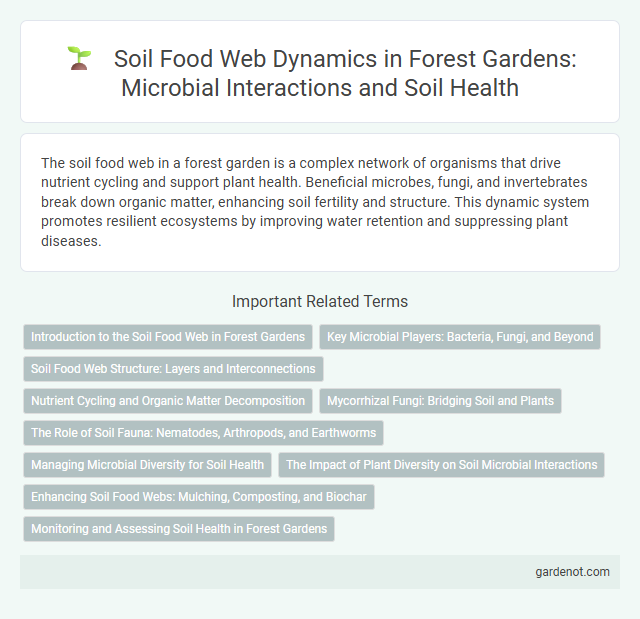The soil food web in a forest garden is a complex network of organisms that drive nutrient cycling and support plant health. Beneficial microbes, fungi, and invertebrates break down organic matter, enhancing soil fertility and structure. This dynamic system promotes resilient ecosystems by improving water retention and suppressing plant diseases.
Introduction to the Soil Food Web in Forest Gardens
The soil food web in forest gardens consists of a complex network of bacteria, fungi, protozoa, nematodes, and arthropods that interact to decompose organic matter and cycle nutrients. These organisms enhance soil structure, improve water retention, and suppress plant pathogens, creating a healthy environment for diverse plants and trees. Understanding the soil food web is crucial for managing forest garden ecosystems sustainably and promoting plant growth naturally.
Key Microbial Players: Bacteria, Fungi, and Beyond
Bacteria in the soil food web play a crucial role in decomposing organic matter and cycling nutrients essential for plant health in a forest garden. Fungi form symbiotic relationships with tree roots through mycorrhizae, enhancing water and nutrient absorption while improving soil structure. Beyond bacteria and fungi, diverse soil organisms like protozoa and nematodes regulate microbial populations and contribute to nutrient mineralization, sustaining the productivity and resilience of the forest garden ecosystem.
Soil Food Web Structure: Layers and Interconnections
The soil food web structure in a forest garden encompasses multiple interconnected layers, including decomposers like fungi and bacteria, microfauna such as nematodes and protozoa, and larger organisms like earthworms and arthropods. These layers interact symbiotically to break down organic matter, recycle nutrients, and enhance soil fertility. Complex interconnections among these organisms drive nutrient cycling, promote plant health, and sustain ecosystem resilience.
Nutrient Cycling and Organic Matter Decomposition
The soil food web in a forest garden is crucial for nutrient cycling, involving microorganisms like bacteria, fungi, and earthworms that break down organic matter into essential nutrients. This decomposition process converts fallen leaves, dead roots, and other organic debris into humus, enriching the soil with nitrogen, phosphorus, and potassium. Efficient nutrient cycling enhances plant growth, boosts soil fertility, and supports a sustainable ecosystem within the forest garden.
Mycorrhizal Fungi: Bridging Soil and Plants
Mycorrhizal fungi form symbiotic relationships with forest garden plants, enhancing nutrient uptake by extending the root system through vast underground networks. These fungi facilitate the transfer of water, phosphorus, and nitrogen between soil particles and plant roots, improving soil structure and fertility. By connecting multiple plants, mycorrhizal networks create a resilient ecosystem that supports biodiversity and promotes sustainable forest garden growth.
The Role of Soil Fauna: Nematodes, Arthropods, and Earthworms
Soil fauna such as nematodes, arthropods, and earthworms play a critical role in maintaining the health and fertility of forest garden ecosystems by breaking down organic matter and cycling nutrients. Nematodes regulate bacterial and fungal populations while aiding nutrient mineralization, arthropods contribute to decomposition and soil aeration, and earthworms enhance soil structure through bioturbation and organic matter incorporation. Their combined activities support a balanced soil food web, promoting plant growth and resilience within sustainable forest gardening practices.
Managing Microbial Diversity for Soil Health
Managing microbial diversity within the soil food web is essential for maintaining robust soil health in forest gardens. Diverse microbial communities enhance nutrient cycling, organic matter decomposition, and disease suppression, which promote plant growth and resilience. Techniques such as incorporating organic mulches, reducing soil disturbance, and planting diverse polycultures support a thriving microbial ecosystem that sustains long-term soil fertility.
The Impact of Plant Diversity on Soil Microbial Interactions
Plant diversity in forest gardens enhances the complexity of the soil food web by promoting varied microbial communities and symbiotic relationships. Diverse plant species contribute different root exudates and organic matter, which stimulate microbial interactions vital for nutrient cycling and soil health. This increased microbial activity supports plant growth, improves disease resistance, and sustains ecosystem stability within the soil environment.
Enhancing Soil Food Webs: Mulching, Composting, and Biochar
Enhancing soil food webs in forest gardens relies heavily on mulching with organic materials, composting diverse plant residues, and incorporating biochar to improve soil structure. These practices increase microbial diversity and activity, promoting nutrient cycling and soil fertility essential for resilient plant growth. Biochar's porous nature provides habitat for beneficial microbes, while composting and mulching supply a steady flow of organic matter that fuels the complex interactions among bacteria, fungi, and soil fauna.
Monitoring and Assessing Soil Health in Forest Gardens
Monitoring and assessing soil health in forest gardens involves analyzing the soil food web, which includes bacteria, fungi, nematodes, and earthworms that drive nutrient cycling and organic matter decomposition. Soil respiration rates, microbial biomass, and nematode community structure serve as key bioindicators, providing insights into soil fertility and ecosystem resilience. Regular soil sampling combined with molecular and microscopic techniques allows precise evaluation of soil biodiversity and functional activity, ensuring optimal conditions for plant growth and forest garden sustainability.
Soil food web Infographic

 gardenot.com
gardenot.com